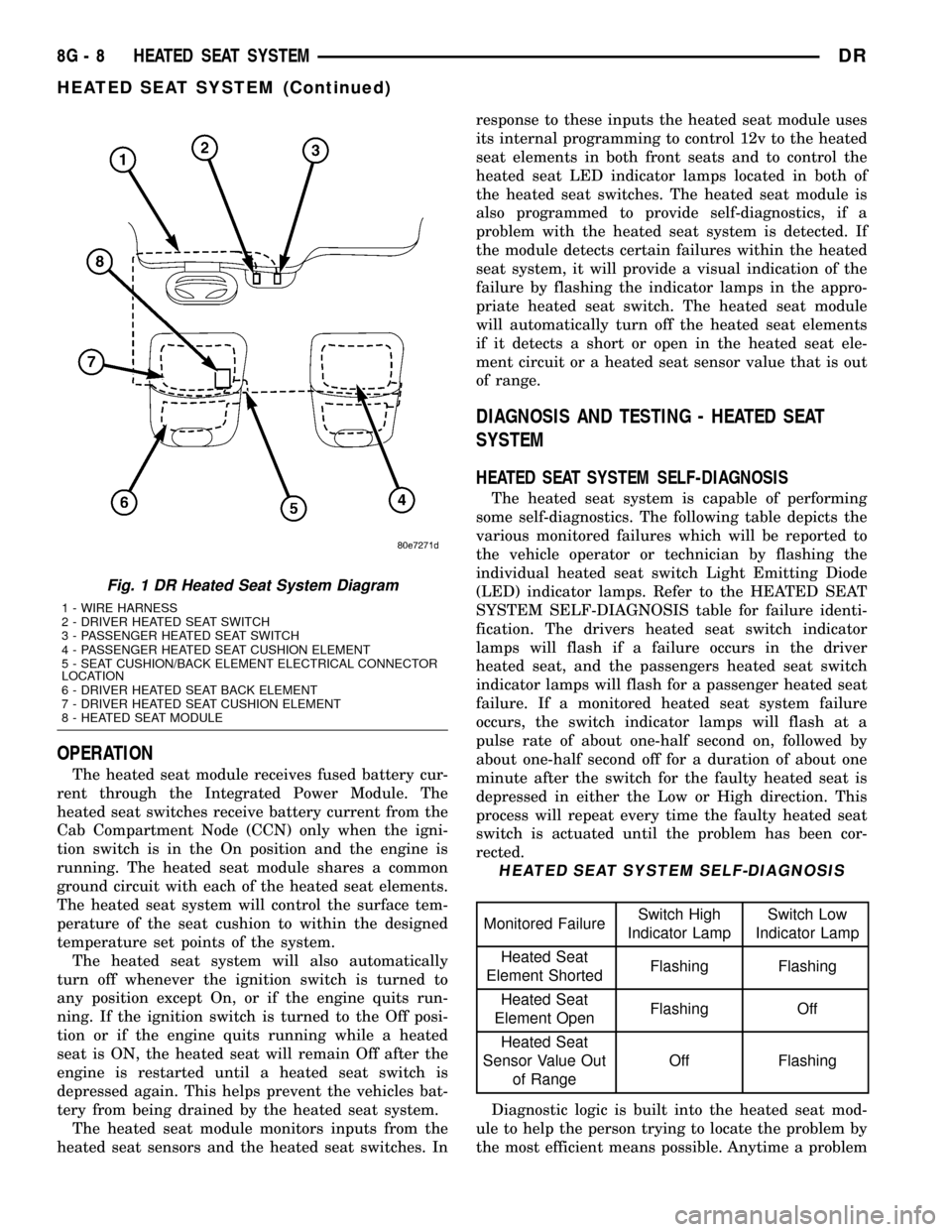Diagnostics port DODGE RAM 1500 1998 2.G Workshop Manual
[x] Cancel search | Manufacturer: DODGE, Model Year: 1998, Model line: RAM 1500, Model: DODGE RAM 1500 1998 2.GPages: 2627
Page 357 of 2627

DIAGNOSIS AND TESTINGÐTHERMOSTAT
ON-BOARD DIAGNOSTICS
Allgasoline powered modelsare equipped with
On-Board Diagnostics for certain cooling system com-
ponents. Refer to On-Board Diagnostics (OBD) in the
Diagnosis section of this group for additional infor-
mation. If the powertrain control module (PCM)
detects low engine coolant temperature, it will record
a Diagnostic Trouble Code (DTC) in the PCM mem-
ory. Do not change a thermostat for lack of heat as
indicated by the instrument panel gauge or by poor
heater performance unless a DTC is present. Refer to
the Diagnosis section of this group for other probable
causes.
The DTC can also be accessed through the
DRBIIItscan tool. Refer to the appropriate Power-
train Diagnostic Procedures information for diagnos-
tic information and operation of the DRBIIItscan
tool.
REMOVAL
WARNING: DO NOT LOOSEN THE RADIATOR
DRAINCOCK WITH THE COOLING SYSTEM HOT
AND PRESSURIZED. SERIOUS BURNS FROM THE
COOLANT CAN OCCUR.Do not waste reusable coolant. If the solution is
clean, drain the coolant into a clean container for
reuse.
If the thermostat is being replaced, be sure that
the replacement is the specified thermostat for the
vehicle model and engine type.
Factory installed thermostat housings on 5.9L
engine is installed on a gasket with an anti-stick
coating. This will aid in gasket removal and clean-up.
(1) Disconnect the negative battery cable.
(2) Drain the cooling system until the coolant level
is below the thermostat (Refer to 7 - COOLING -
STANDARD PROCEDURE).
(3) Air Conditioned vehicles: Remove the support
bracket (generator mounting bracket-to-intake mani-
fold) located near the rear of the generator (Fig. 17).
NOTE: On air conditioning equipped vehicles, the
generator must be partially removed.
(4) Remove the accessory drive belt (Refer to 7 -
COOLING/ACCESSORY DRIVE/DRIVE BELTS -
REMOVAL) (Fig. 18).
(5) Remove the generator mounting bolts. Do not
remove any of the wiring at the generator. If
equipped with 4WD, unplug the 4WD indicator lamp
wiring harness (located near rear of generator).
(6) Remove the generator. Position the generator
to gain access for the thermostat gasket removal.
WARNING: CONSTANT TENSION HOSE CLAMPS
ARE USED ON MOST COOLING SYSTEM HOSES.
WHEN REMOVING OR INSTALLING, USE ONLY
TOOLS DESIGNED FOR SERVICING THIS TYPE OF
CLAMP. ALWAYS WEAR SAFETY GLASSES WHEN
SERVICING CONSTANT TENSION CLAMPS.
Fig. 16 Thermostat - 5.7L/5.9L Gas Powered
Engines
1 - THERMOSTAT HOUSING
2 - GASKET
3 - INTAKE MANIFOLD
4 - THERMOSTAT
5 - MACHINED GROOVE
Fig. 17 Generator Support Bracket ± 5.9L Engine
1 - IDLER PULLEY BUSHING
2 - A/C AND/OR GENERATOR MOUNTING BRACKET
3 - IDLER PULLEY
4 - SCREW AND WASHER
7 - 42 ENGINEDR
ENGINE COOLANT THERMOSTAT- 5.7L (Continued)
Page 359 of 2627

(7) Air Conditioned vehicles; Install the generator.
Tighten the bolts to 41 N´m (30 ft. lbs.).
(8) Install the support bracket (generator mount-
ing bracket-to-intake manifold). (Fig. 17). Tighten the
bolts to 54 N´m (40 ft. lbs.).
(9) Install the accessory drive belt (Fig. 18)(Refer
to 7 - COOLING/ACCESSORY DRIVE/DRIVE
BELTS - INSTALLATION).
(10) Fill the cooling system (Refer to 7 - COOLING
- STANDARD PROCEDURE).
(11) Connect battery negative cable.
(12) Start and warm the engine. Check for leaks.
ENGINE COOLANT
THERMOSTAT - 3.7L/4.7L
DESCRIPTION
CAUTION: Do not operate the engine without a ther-
mostat, except for servicing or testing.
A pellet-type thermostat controls the operating
temperature of the engine by controlling the amount
of coolant flow to the radiator. On all engines the
thermostat is closed below 195ÉF (90ÉC). Above this
temperature, coolant is allowed to flow to the radia-
tor. This provides quick engine warm up and overall
temperature control. On the 3.7L4.7L engine the
thermostat is designed to block the flow of the cool-
ant bypass journal by 50% instead of completely
blocking the flow. This design controls coolant tem-
perature more accurately (Fig. 23).The same thermostat is used for winter and sum-
mer seasons. An engine should not be operated with-
out a thermostat, except for servicing or testing.
Operating without a thermostat causes other prob-
lems. These are: longer engine warmup time, unreli-
able warmup performance, increased exhaust
emissions and crankcase condensation. This conden-
sation can result in sludge formation.
OPERATION
The wax pellet is located in a sealed container at
the spring end of the thermostat. When heated, the
pellet expands, overcoming closing spring tension
and water pump pressure to force the valve to open.
DIAGNOSIS AND TESTINGÐTHERMOSTAT
ON-BOARD DIAGNOSTICS
Allgasoline powered modelsare equipped with
On-Board Diagnostics for certain cooling system com-
ponents. Refer to On-Board Diagnostics (OBD) in the
Diagnosis section of this group for additional infor-
mation. If the powertrain control module (PCM)
detects low engine coolant temperature, it will record
a Diagnostic Trouble Code (DTC) in the PCM mem-
ory. Do not change a thermostat for lack of heat as
Fig. 21 Thermostat PositionÐ5.9L EnginesFig. 22 Belt Routing ± 5.9L Engines
1 - IDLER PULLEY
2 - GENERATOR PULLEY
3 - A/C COMPRESSOR PULLEY
4 - IF W/OUT A/C
5 - POWER STEERING PUMP PULLEY
6 - WATER PUMP PULLEY
7 - CRANKSHAFT PULLEY
8 - AUTOMATIC TENSIONER
7 - 44 ENGINEDR
ENGINE COOLANT THERMOSTAT- 5.7L (Continued)
Page 427 of 2627

TRANSMISSION CONTROL
MODULE
DESCRIPTION
The Transmission Control Module (TCM) (Fig. 9)
may be sub-module within the Powertrain Control
Module (PCM), Engine Control Module (ECM - Diesel
only) (Fig. 10), or a standalone module, depending on
the vehicle engine. The PCM, and TCM when
equipped, is located at the right rear of the engine
compartment, near the right inner fender.
OPERATION
The Transmission Control Module (TCM) controls
all electronic operations of the transmission. The
TCM receives information regarding vehicle opera-
tion from both direct and indirect inputs, and selects
the operational mode of the transmission. Direct
inputs are hardwired to, and used specifically by the
TCM. Indirect inputs are shared with the TCM via
the vehicle communication bus.
Some examples ofdirect inputsto the TCM are:
²Battery (B+) voltage
²Ignition ªONº voltage
²Transmission Control Relay (Switched B+)
²Throttle Position Sensor
²Crankshaft Position Sensor
²Transmission Range Sensor
²Pressure Switches
²Transmission Temperature Sensor
²Input Shaft Speed Sensor
²Output Shaft Speed Sensor
²Line Pressure Sensor
Some examples ofindirect inputsto the TCM
are:²Engine/Body Identification
²Manifold Pressure
²Target Idle
²Torque Reduction Confirmation
²Engine Coolant Temperature
²Ambient/Battery Temperature
²DRBIIItScan Tool Communication
Based on the information received from these var-
ious inputs, the TCM determines the appropriate
shift schedule and shift points, depending on the
present operating conditions and driver demand.
This is possible through the control of various direct
and indirect outputs.
Some examples of TCMdirect outputsare:
²Transmission Control Relay
²Solenoids
²Torque Reduction Request
Some examples of TCMindirect outputsare:
²Transmission Temperature (to PCM)
²PRNDL Position (to BCM)
In addition to monitoring inputs and controlling
outputs, the TCM has other important responsibili-
ties and functions:
²Storing and maintaining Clutch Volume Indexes
(CVI)
²Storing and selecting appropriate Shift Sched-
ules
²System self-diagnostics
Fig. 9 PCM/TCM Location
1 - RIGHT FENDER
2 - TRANSMISSION CONTROL MODULE
3 - POWERTRAIN CONTROL MODULE
Fig. 10 Diesel ECM
1 - ENGINE CONTROL MODULE (ECM)
2 - ECM MOUNTING BOLT
3 - 50-WAY CONNECTOR
4 - SUPPORT PLATE
5 - 60-WAY CONNECTOR
8E - 20 ELECTRONIC CONTROL MODULESDR
Page 433 of 2627

For battery system maintenance schedules and
jump starting procedures, see the owner's manual in
the vehicle glove box. Optionally, refer to the Lubri-
cation and Maintenance section of this manual for
the proper battery jump starting procedure. While
battery charging can be considered a maintenance
procedure, the battery charging procedure and
related information are located later in this section of
the service manual. This was done because the bat-
tery must be fully-charged before any battery system
diagnosis or testing procedures can be performed.
OPERATION
The battery system is designed to provide a safe,
efficient, reliable and mobile means of delivering and
storing electrical energy. This electrical energy is
required to operate the engine starting system, as
well as to operate many of the other vehicle acces-
sory systems for limited durations while the engine
and/or the charging system are not operating. The
battery system is also designed to provide a reserve
of electrical energy to supplement the charging sys-
tem for short durations while the engine is running
and the electrical current demands of the vehicle
exceed the output of the charging system. In addition
to delivering, and storing electrical energy for the
vehicle, the battery system serves as a capacitor and
voltage stabilizer for the vehicle electrical system. It
absorbs most abnormal or transient voltages caused
by the switching of any of the electrical components
or circuits in the vehicle.
DIAGNOSIS AND TESTING - BATTERY SYSTEM
The battery, starting, and charging systems in the
vehicle operate with one another and must be tested
as a complete system. In order for the engine to start
and the battery to maintain its charge properly, all of
the components that are used in these systems must
perform within specifications. It is important thatthe battery, starting, and charging systems be thor-
oughly tested and inspected any time a battery needs
to be charged or replaced. The cause of abnormal bat-
tery discharge, overcharging or early battery failure
must be diagnosed and corrected before a battery is
replaced and before a vehicle is returned to service.
The service information for these systems has been
separated within this service manual to make it eas-
ier to locate the specific information you are seeking.
However, when attempting to diagnose any of these
systems, it is important that you keep their interde-
pendency in mind.
The diagnostic procedures used for the battery,
starting, and charging systems include the most
basic conventional diagnostic methods, to the more
sophisticated On-Board Diagnostics (OBD) built into
the Powertrain Control Module (PCM). Use of an
induction-type milliampere ammeter, a volt/ohmme-
ter, a battery charger, a carbon pile rheostat (load
tester), a 12-volt test lamp and/or special service
tools may be required. All OBD-sensed systems are
monitored by the PCM. Each monitored circuit is
assigned a Diagnostic Trouble Code (DTC). The PCM
will store a DTC in electronic memory for any failure
it detects. Always check the PCM for stored trouble
codes before returning the vehicle to service. Refer to
Charging System for the proper charging system test
procedures. Refer to Starting System for the proper
starting system test procedures.
MICRO 420 BATTERY TESTER
The Micro 420 automotive battery tester is
designed to help the dealership technician diagnose a
defective battery. Follow the instruction manual sup-
plied with the tester to properly diagnose a battery.
If the instruction manual is not available, refer to
the standard procedure in this section, which
includes the directions for using the Micro 420 bat-
tery tester.
8F - 2 BATTERY SYSTEMDR
BATTERY SYSTEM (Continued)
Page 477 of 2627

OPERATION
The heated seat module receives fused battery cur-
rent through the Integrated Power Module. The
heated seat switches receive battery current from the
Cab Compartment Node (CCN) only when the igni-
tion switch is in the On position and the engine is
running. The heated seat module shares a common
ground circuit with each of the heated seat elements.
The heated seat system will control the surface tem-
perature of the seat cushion to within the designed
temperature set points of the system.
The heated seat system will also automatically
turn off whenever the ignition switch is turned to
any position except On, or if the engine quits run-
ning. If the ignition switch is turned to the Off posi-
tion or if the engine quits running while a heated
seat is ON, the heated seat will remain Off after the
engine is restarted until a heated seat switch is
depressed again. This helps prevent the vehicles bat-
tery from being drained by the heated seat system.
The heated seat module monitors inputs from the
heated seat sensors and the heated seat switches. Inresponse to these inputs the heated seat module uses
its internal programming to control 12v to the heated
seat elements in both front seats and to control the
heated seat LED indicator lamps located in both of
the heated seat switches. The heated seat module is
also programmed to provide self-diagnostics, if a
problem with the heated seat system is detected. If
the module detects certain failures within the heated
seat system, it will provide a visual indication of the
failure by flashing the indicator lamps in the appro-
priate heated seat switch. The heated seat module
will automatically turn off the heated seat elements
if it detects a short or open in the heated seat ele-
ment circuit or a heated seat sensor value that is out
of range.
DIAGNOSIS AND TESTING - HEATED SEAT
SYSTEM
HEATED SEAT SYSTEM SELF-DIAGNOSIS
The heated seat system is capable of performing
some self-diagnostics. The following table depicts the
various monitored failures which will be reported to
the vehicle operator or technician by flashing the
individual heated seat switch Light Emitting Diode
(LED) indicator lamps. Refer to the HEATED SEAT
SYSTEM SELF-DIAGNOSIS table for failure identi-
fication. The drivers heated seat switch indicator
lamps will flash if a failure occurs in the driver
heated seat, and the passengers heated seat switch
indicator lamps will flash for a passenger heated seat
failure. If a monitored heated seat system failure
occurs, the switch indicator lamps will flash at a
pulse rate of about one-half second on, followed by
about one-half second off for a duration of about one
minute after the switch for the faulty heated seat is
depressed in either the Low or High direction. This
process will repeat every time the faulty heated seat
switch is actuated until the problem has been cor-
rected.
HEATED SEAT SYSTEM SELF-DIAGNOSIS
Monitored FailureSwitch High
Indicator LampSwitch Low
Indicator Lamp
Heated Seat
Element ShortedFlashing Flashing
Heated Seat
Element OpenFlashing Off
Heated Seat
Sensor Value Out
of RangeOff Flashing
Diagnostic logic is built into the heated seat mod-
ule to help the person trying to locate the problem by
the most efficient means possible. Anytime a problem
Fig. 1 DR Heated Seat System Diagram
1 - WIRE HARNESS
2 - DRIVER HEATED SEAT SWITCH
3 - PASSENGER HEATED SEAT SWITCH
4 - PASSENGER HEATED SEAT CUSHION ELEMENT
5 - SEAT CUSHION/BACK ELEMENT ELECTRICAL CONNECTOR
LOCATION
6 - DRIVER HEATED SEAT BACK ELEMENT
7 - DRIVER HEATED SEAT CUSHION ELEMENT
8 - HEATED SEAT MODULE
8G - 8 HEATED SEAT SYSTEMDR
HEATED SEAT SYSTEM (Continued)
Page 540 of 2627

MALFUNCTION INDICATOR
LAMP (MIL)
DESCRIPTION
A Malfunction Indicator Lamp (MIL) is standard
equipment on all instrument clusters (Fig. 22). The
MIL is located on the left side of the instrument clus-
ter, to the left of the voltage gauge. The MIL consists
of a stencil-like cutout of the International Control
and Display Symbol icon for ªEngineº in the opaque
layer of the instrument cluster overlay. The dark
outer layer of the overlay prevents the indicator from
being clearly visible when it is not illuminated. An
amber Light Emitting Diode (LED) behind the cutout
in the opaque layer of the overlay causes the icon to
appear in amber through the translucent outer layer
of the overlay when the indicator is illuminated from
behind by the LED, which is soldered onto the
instrument cluster electronic circuit board. The MIL
is serviced as a unit with the instrument cluster.
OPERATION
The Malfunction Indicator Lamp (MIL) gives an
indication to the vehicle operator when the Power-
train Control Module (PCM) on vehicles with a gaso-
line engine, or the Engine Control Module (ECM) on
vehicles with a diesel engine has recorded a Diagnos-
tic Trouble Code (DTC) for an On-Board Diagnostics
II (OBDII) emissions-related circuit or component
malfunction. The MIL is controlled by a transistor on
the instrument cluster circuit board based upon clus-
ter programming and electronic messages received by
the cluster from the PCM or ECM over the Program-
mable Communications Interface (PCI) data bus. The
MIL Light Emitting Diode (LED) is completely con-
trolled by the instrument cluster logic circuit, and
that logic will only allow this indicator to operate
when the instrument cluster receives a battery cur-
rent input on the fused ignition switch output (run-
start) circuit. Therefore, the LED will always be off
when the ignition switch is in any position except On
or Start. The LED only illuminates when it is pro-
vided a path to ground by the instrument cluster
transistor. The instrument cluster will turn on the
MIL for the following reasons:
²Bulb Test- Each time the ignition switch is
turned to the On position the indicator is illuminated
for about two seconds as a bulb test. The entire two
second bulb test is a function of the PCM or ECM.²MIL Lamp-On Message- Each time the clus-
ter receives a MIL lamp-on message from the PCM
or ECM, the indicator will be illuminated. The indi-
cator can be flashed on and off, or illuminated solid,
as dictated by the PCM or ECM message. For some
DTC's, if a problem does not recur, the PCM or ECM
will send a lamp-off message automatically. Other
DTC's may require that a fault be repaired and the
PCM or ECM be reset before a lamp-off message will
be sent. For more information on the PCM, the ECM,
and the DTC set and reset parameters, (Refer to 25 -
EMISSIONS CONTROL - OPERATION).
²Communication Error- If the cluster receives
no lamp-on message from the PCM or ECM for ten
seconds, the MIL is illuminated by the instrument
cluster to indicate a loss of bus communication. The
indicator remains controlled and illuminated by the
cluster until a valid lamp-on message is received
from the PCM or ECM.
²Actuator Test- Each time the cluster is put
through the actuator test, the MIL indicator will be
turned on during the bulb check portion of the test to
confirm the functionality of the LED and the cluster
control circuitry.
On vehicles with a gasoline engine, the PCM con-
tinually monitors the fuel and emissions system cir-
cuits and sensors to decide whether the system is in
good operating condition. On vehicles with a diesel
engine, the ECM continually monitors the fuel and
emissions system circuits and sensors to decide
whether the system is in good operating condition.
The PCM or ECM then sends the proper lamp-on or
lamp-off messages to the instrument cluster. For fur-
ther diagnosis of the MIL or the instrument cluster
circuitry that controls the LED, (Refer to 8 - ELEC-
TRICAL/INSTRUMENT CLUSTER - DIAGNOSIS
AND TESTING). If the instrument cluster turns on
the MIL after the bulb test, it may indicate that a
malfunction has occurred and that the fuel and emis-
sions systems may require service. For proper diag-
nosis of the fuel and emissions systems, the PCM,
the ECM, the PCI data bus, or the electronic mes-
sage inputs to the instrument cluster that control the
MIL, a DRBIIItscan tool is required. Refer to the
appropriate diagnostic information.
Fig. 22 Malfunction Indicator Lamp (MIL)
DRINSTRUMENT CLUSTER 8J - 31
Page 630 of 2627

AIRBAG CONTROL MODULE
DESCRIPTION
The Airbag Control Module (ACM) is also some-
times referred to as the Occupant Restraint Control-
ler (ORC) (Fig. 7). The ACM is concealed below the
instrument panel center stack in the passenger com-
partment of the vehicle, where it is secured by three
screws to a stamped steel mounting bracket welded
onto the top of the floor panel transmission tunnel
just forward of the instrument panel center support
bracket. Concealed within a hollow in the center of
the die cast aluminum ACM housing is the electronic
circuitry of the ACM which includes a microproces-
sor, an electronic impact sensor, an electronic safing
sensor, and an energy storage capacitor. A stamped
metal cover plate is secured to the bottom of the
ACM housing with four screws to enclose and protect
the internal electronic circuitry and components.
An arrow printed on the label on the top of the
ACM housing provides a visual verification of the
proper orientation of the unit, and should always be
pointed toward the front of the vehicle. The ACM
housing has integral mounting flanges on three cor-
ners. The mounting flange to the left of the connector
receptacle has an integral locating pin on its lower
surface. Both left side flanges have round mounting
holes, while the flange on the right side has a slotted
mounting hole. A molded plastic electrical connector
with two receptacles, one containing twenty-four ter-
minal pins and the other containing thirty-two termi-
nal pins, exits the rearward facing side of the ACM
housing. These terminal pins connect the ACM to the
vehicle electrical system through two dedicated takeouts and connectors of the instrument panel wire
harness.
The impact sensor and safing sensor internal to
the ACM are calibrated for the specific vehicle, and
are only serviced as a unit with the ACM. In addi-
tion, there are unique versions of the ACM for light
and heavy-duty models, and for vehicles with or
without the optional side curtain airbags. The ACM
cannot be repaired or adjusted and, if damaged or
faulty, it must be replaced.
OPERATION
The microprocessor in the Airbag Control Module
(ACM) contains the supplemental restraint system
logic circuits and controls all of the supplemental
restraint system components. The ACM uses
On-Board Diagnostics (OBD) and can communicate
with other electronic modules in the vehicle as well
as with the DRBIIItscan tool using the Programma-
ble Communications Interface (PCI) data bus net-
work. This method of communication is used for
control of the airbag indicator in the ElectroMechani-
cal Instrument Cluster (EMIC) and for supplemental
restraint system diagnosis and testing through the
16-way data link connector located on the driver side
lower edge of the instrument panel. (Refer to 8 -
ELECTRICAL/INSTRUMENT CLUSTER/AIRBAG
INDICATOR - OPERATION).
The ACM microprocessor continuously monitors all
of the supplemental restraint system electrical cir-
cuits to determine the system readiness. If the ACM
detects a monitored system fault, it sets an active
and stored Diagnostic Trouble Code (DTC) and sends
electronic messages to the EMIC over the PCI data
bus to turn on the airbag indicator. An active fault
only remains for the duration of the fault, or in some
cases for the duration of the current ignition switch
cycle, while a stored fault causes a DTC to be stored
in memory by the ACM. For some DTCs, if a fault
does not recur for a number of ignition cycles, the
ACM will automatically erase the stored DTC. For
other internal faults, the stored DTC is latched for-
ever.
In standard cab models, the ACM also monitors a
resistor multiplexed input from the passenger airbag
on/off switch and provides a control output for the
Off indicator in the switch through a passenger air-
bag indicator driver circuit. If the passenger airbag
on/off switch is set to the Off position, the ACM turns
on the passenger airbag on/off switch Off indicator
and will internally disable the passenger airbag from
being deployed. The ACM also turns on the on/off
switch Off indicator for about seven seconds each
time the ignition switch is turned to the On position
as a bulb test. Following the bulb test, the ACM con-
trols the status of the Off indicator based upon the
Fig. 7 Airbag Control Module
1 - AIRBAG CONTROL MODULE
2 - ORIENTATION ARROW
3 - LABEL
4 - CONNECTOR RECEPTACLE (2)
DRRESTRAINTS 8O - 11
Page 2574 of 2627

FUEL FILLER CAP
DESCRIPTION
The plastic fuel tank filler tube cap is threaded
onto the end of the fuel fill tube. Certain models are
equipped with a 1/4 turn cap.
OPERATION
The loss of any fuel or vapor out of fuel filler tube
is prevented by the use of a pressure-vacuum fuel fill
cap. Relief valves inside the cap will release fuel tank
pressure at predetermined pressures. Fuel tank vac-
uum will also be released at predetermined values.
This cap must be replaced by a similar unit if
replacement is necessary. This is in order for the sys-
tem to remain effective.
CAUTION: Remove fill cap before servicing any fuel
system component to relieve tank pressure. If
equipped with a Leak Detection Pump (LDP), or
NVLD system, the cap must be tightened securely.
If cap is left loose, a Diagnostic Trouble Code (DTC)
may be set.
REMOVAL
REMOVAL/INSTALLATION
If replacement of the 1/4 turn fuel tank filler tube
cap is necessary, it must be replaced with an identi-
cal cap to be sure of correct system operation.
CAUTION: Remove the fuel tank filler tube cap to
relieve fuel tank pressure. The cap must be
removed prior to disconnecting any fuel system
component or before draining the fuel tank.
LEAK DETECTION PUMP
DESCRIPTION
Vehicles equipped with JTEC engine control mod-
ules use a leak detection pump. Vehicles equipped
with NGC engine control modules use an NVLD
pump. Refer to Natural Vacuum - Leak Detection
(NVLD) for additional information.
The evaporative emission system is designed to
prevent the escape of fuel vapors from the fuel sys-
tem (Fig. 4). Leaks in the system, even small ones,
can allow fuel vapors to escape into the atmosphere.
Government regulations require onboard testing to
make sure that the evaporative (EVAP) system is
functioning properly. The leak detection system tests
for EVAP system leaks and blockage. It also performs
self-diagnostics. During self-diagnostics, the Power-
train Control Module (PCM) first checks the Leak
Detection Pump (LDP) for electrical and mechanical
faults. If the first checks pass, the PCM then uses
the LDP to seal the vent valve and pump air into the
system to pressurize it. If a leak is present, the PCM
will continue pumping the LDP to replace the air
that leaks out. The PCM determines the size of the
leak based on how fast/long it must pump the LDP
as it tries to maintain pressure in the system.
EVAP LEAK DETECTION SYSTEM COMPONENTS
Service Port: Used with special tools like the Miller
Evaporative Emissions Leak Detector (EELD) to test
for leaks in the system.
EVAP Purge Solenoid: The PCM uses the EVAP
purge solenoid to control purging of excess fuel
vapors stored in the EVAP canister. It remains closed
during leak testing to prevent loss of pressure.
EVAP Canister: The EVAP canister stores fuel
vapors from the fuel tank for purging.
EVAP Purge Orifice: Limits purge volume.
EVAP System Air Filter: Provides air to the LDP
for pressurizing the system. It filters out dirt while
allowing a vent to atmosphere for the EVAP system.
Fig. 3 EVAP / DUTY CYCLE PURGE SOLENOID
1 - MOUNTING BRACKET
2 - VACUUM HARNESS
3 - DUTY CYCLE SOLENOID
4 - TEST PORT CAP AND TEST PORT
DREVAPORATIVE EMISSIONS 25 - 13
EVAP/PURGE SOLENOID (Continued)
Page 2609 of 2627

NV243 - TRANSFER CASE.......21-505,21-506
NV244 - DIAGNOSIS AND TESTING,
TRANSFER CASE....................21-513
NV244 GENII - ASSEMBLY, TRANSFER
CASE.............................21-525
NV244 GENII - CLEANING, TRANSFER
CASE.............................21-523
NV244 GENII - DESCRIPTION, TRANSFER
CASE.............................21-512
NV244 GENII - DISASSEMBLY,
TRANSFER CASE....................21-514
NV244 GENII - INSPECTION, TRANSFER
CASE.............................21-523
NV244 GENII - INSTALLATION,
TRANSFER CASE....................21-534
NV244 GENII - OPERATION, TRANSFER
CASE.............................21-513
NV244 GENII - REMOVAL, TRANSFER
CASE.............................21-514
NV244 GENII - TRANSFER CASE........21-535
NV271 - ASSEMBLY, TRANSFER CASE . . . 21-461
NV271 - CLEANING, TRANSFER CASE . . . 21-459
NV271 - DESCRIPTION, TRANSFER CASE . 21-447
NV271 - DIAGNOSIS AND TESTING,
TRANSFER CASE....................21-448
NV271 - DISASSEMBLY, TRANSFER
CASE.............................21-450
NV271 - INSPECTION, TRANSFER CASE . . 21-459
NV271 - INSTALLATION, TRANSFER
CASE.............................21-473
NV271 - OPERATION, TRANSFER CASE . . 21-448
NV271 - REMOVAL, TRANSFER CASE....21-450
NV271 - TRANSFER CASE.............21-473
NV271/NV273, SPECIAL TOOLS -
TRANSFER CASE..............21-474,21-569
NV273 - ASSEMBLY, TRANSFER CASE . . . 21-556
NV273 - CLEANING, TRANSFER CASE . . . 21-554
NV273 - DESCRIPTION, TRANSFER CASE . 21-542
NV273 - DIAGNOSIS AND TESTING,
TRANSFER CASE....................21-543
NV273 - DISASSEMBLY, TRANSFER
CASE.............................21-544
NV273 - INSPECTION, TRANSFER CASE . . 21-554
NV273 - INSTALLATION, TRANSFER
CASE.............................21-568
NV273 - OPERATION, TRANSFER CASE . . 21-543
NV273 - REMOVAL, TRANSFER CASE....21-544
NV273 - TRANSFER CASE.............21-568
NV3500 - ASSEMBLY, MANUAL
TRANSMISSION......................21-17
NV3500 - CLEANING, MANUAL
TRANSMISSION......................21-15
NV3500 - DESCRIPTION, MANUAL
TRANSMISSION.......................21-1
NV3500 - DIAGNOSIS AND TESTING,
MANUAL TRANSMISSION...............21-3
NV3500 - DISASSEMBLY, MANUAL
TRANSMISSION.......................21-4
NV3500 - INSPECTION, MANUAL
TRANSMISSION......................21-16
NV3500 - INSTALLATION, MANUAL
TRANSMISSION......................21-39
NV3500 - OPERATION, MANUAL
TRANSMISSION.......................21-1
NV3500 - REMOVAL, MANUAL
TRANSMISSION.......................21-3
NV3500 - SPECIAL TOOLS, MANUAL
TRANSMISSION......................21-40
NV3500 - SPECIFICATIONS, MANUAL
TRANSMISSION......................21-40
NV4500 - ASSEMBLY, MANUAL
TRANSMISSION......................21-63
NV4500 - CLEANING, MANUAL
TRANSMISSION......................21-62
NV4500 - DESCRIPTION, MANUAL
TRANSMISSION......................21-43
NV4500 - DIAGNOSIS AND TESTING,
MANUAL TRANSMISSION..............21-44
NV4500 - DISASSEMBLY, MANUAL
TRANSMISSION
......................21-46
NV4500 - INSPECTION, MANUAL
TRANSMISSION
......................21-62
NV4500 - INSTALLATION, MANUAL
TRANSMISSION
......................21-80
NV4500 - OPERATION, MANUAL
TRANSMISSION
......................21-43
NV4500 - REMOVAL, MANUAL
TRANSMISSION
......................21-44NV4500 - SPECIAL TOOLS, MANUAL
TRANSMISSION......................21-81
NV4500 - SPECIFICATIONS, MANUAL
TRANSMISSION......................21-81
NV5600 - ASSEMBLY, MANUAL
TRANSMISSION.....................21-106
NV5600 - DESCRIPTION, MANUAL
TRANSMISSION......................21-88
NV5600 - DIAGNOSIS AND TESTING,
MANUAL TRANSMISSION..............21-90
NV5600 - DISASSEMBLY, MANUAL
TRANSMISSION......................21-91
NV5600 - INSPECTION, MANUAL
TRANSMISSION.....................21-106
NV5600 - INSTALLATION, MANUAL
TRANSMISSION.....................21-121
NV5600 - OPERATION, MANUAL
TRANSMISSION......................21-90
NV5600 - REMOVAL, MANUAL
TRANSMISSION......................21-90
NV5600 - SPECIAL TOOLS, MANUAL
TRANSMISSION.....................21-123
NV5600 - SPECIFICATIONS............21-123
ODOMETER - DESCRIPTION............8J-32
ODOMETER - OPERATION..............8J-32
OIL - DESCRIPTION, REFRIGERANT......24-68
OIL - DIESEL ENGINES - DESCRIPTION,
ENGINE..............................0-2
OIL - OPERATION, REFRIGERANT........24-69
OIL AND LUBRICANTS - DESCRIPTION,
ENGINE..............................0-1
OIL COOLER - INSTALLATION, AIR TO......7-70
OIL COOLER - REMOVAL, AIR TO.........7-69
OIL COOLER - REMOVAL, WATER TO......7-69
OIL FILTER - INSTALLATION . 9-155,9-223,9-293,
9-70
OIL FILTER - REMOVAL . 9-154,9-223,9-293,9-70
OIL LEAK - DIAGNOSIS AND TESTING,
ENGINE...................9-152,9-220,9-64
OIL LEVEL - STANDARD PROCEDURE,
ENGINE............................9-292
OIL LEVEL - STANDARD PROCEDURE,
REFRIGERANT.......................24-69
OIL PAN - CLEANING.............9-293,9-66
OIL PAN - DESCRIPTION................9-66
OIL PAN - INSPECTION............9-293,9-66
OIL PAN - INSTALLATION . . . 9-155,9-224,9-293,
9-66
OIL PAN - REMOVAL....9-155,9-224,9-293,9-66
OIL PRESSURE - DIAGNOSIS AND
TESTING, CHECKING ENGINE . . 9-152,9-220,9-65
OIL PRESSURE - DIAGNOSIS AND
TESTING, ENGINE....................9-289
OIL PRESSURE GAUGE - DESCRIPTION . . . 8J-33
OIL PRESSURE GAUGE - OPERATION.....8J-33
OIL PRESSURE RELIEF VALVE -
CLEANING..........................9-294
OIL PRESSURE RELIEF VALVE -
INSPECTION........................9-294
OIL PRESSURE RELIEF VALVE -
INSTALLATION.......................9-294
OIL PRESSURE RELIEF VALVE -
REMOVAL..........................9-294
OIL PRESSURE SENSOR/SWITCH -
DESCRIPTION........................9-67
OIL PRESSURE SENSOR/SWITCH -
INSTALLATION........................9-67
OIL PRESSURE SENSOR/SWITCH -
OPERATION..........................9-67
OIL PRESSURE SENSOR/SWITCH -
REMOVAL...........................9-67
OIL PRESSURE SWITCH - INSTALLATION . 9-294
OIL PRESSURE SWITCH - REMOVAL.....9-294
OIL PUMP - ASSEMBLY...........9-158,9-69
OIL PUMP - ASSEMBLY........21-214,21-390
OIL PUMP - CLEANING......9-157,9-224,9-295
OIL PUMP - CLEANING.........21-214,21-390
OIL PUMP - DESCRIPTION......21-213,21-386
OIL PUMP - DISASSEMBLY........9-157,9-68
OIL PUMP - DISASSEMBLY......21-214,21-388
OIL PUMP - INSPECTION....9-157,9-224,9-295,
9-68
OIL PUMP - INSPECTION
.......21-214,21-390
OIL PUMP - INSTALLATION
. . 9-159,9-225,9-296,
9-69
OIL PUMP - OPERATION
........21-213,21-386
OIL PUMP - REMOVAL
. . 9-156,9-224,9-294,9-67
OIL PUMP FRONT SEAL - INSTALLATION
. 21-391OIL PUMP FRONT SEAL - REMOVAL....21-391
OIL PUMP VOLUME CHECK - STANDARD
PROCEDURE.......................21-387
OIL SEAL - FRONT - INSTALLATION,
CRANKSHAFT.........9-136,9-208,9-275,9-46
OIL SEAL - FRONT - REMOVAL,
CRANKSHAFT.........9-135,9-208,9-275,9-46
OIL SEAL - REAR - INSTALLATION,
CRANKSHAFT.........9-138,9-209,9-276,9-47
OIL SEAL - REAR - REMOVAL,
CRANKSHAFT.........9-137,9-209,9-276,9-47
OIL SEAL RETAINER - INSTALLATION,
CRANKSHAFT REAR.............9-210,9-277
OIL SEAL RETAINER - REMOVAL,
CRANKSHAFT REAR.............9-209,9-277
OIL SERVICE - STANDARD PROCEDURE,
ENGINE..............9-153,9-222,9-292,9-71
ON-BOARD DIAGNOSTICS (OBD) -
DIAGNOSIS AND TESTING...............7-5
ON/OFF RELAY - DESCRIPTION, WIPER . . . 8R-24
ON/OFF RELAY - DIAGNOSIS AND
TESTING, WIPER.....................8R-25
ON/OFF RELAY - INSTALLATION, WIPER . . 8R-26
ON/OFF RELAY - OPERATION, WIPER....8R-25
ON/OFF RELAY - REMOVAL, WIPER......8R-26
ON/OFF SWITCH - DESCRIPTION,
PASSENGER AIRBAG.................8O-42
ON/OFF SWITCH - INSTALLATION,
PASSENGER AIRBAG.................8O-44
ON/OFF SWITCH - OPERATION,
PASSENGER AIRBAG.................8O-43
ON/OFF SWITCH - REMOVAL,
PASSENGER AIRBAG.................8O-43
OPEN-CIRCUIT VOLTAGE TEST -
STANDARD PROCEDURE...............8F-10
OPENING COVER - INSTALLATION,
STEERING COLUMN..................23-60
OPENING COVER - REMOVAL, STEERING
COLUMN...........................23-60
OPENING DIMENSIONS -
SPECIFICATIONS, BODY...............23-99
OPENING SEAL - INSTALLATION, DOOR . . . 23-92
OPENING SEAL - REMOVAL, DOOR......23-92
OPENING SUPPORT BRACKET -
INSTALLATION, STEERING COLUMN......23-60
OPENING SUPPORT BRACKET -
REMOVAL, STEERING COLUMN.........23-60
OPERATING MODES, STANDARD
PROCEDURE - CONFIGURING A NEW
MODULE / SWITCH....................8Q-3
ORDER / CABLE ROUTING, 5.7L V-8
ENGINE - FIRING......................8I-4
ORDER, 3.7L V-6 - ENGINE FIRING........8I-4
ORDER, 4.7L V-8 - ENGINE FIRING........8I-4
ORDER, DIESEL - FUEL INJECTOR
FIRING.............................14-48
ORIFICE TUBE - DESCRIPTION, A/C......24-60
ORIFICE TUBE - DIAGNOSIS AND
TESTING, A/C.......................24-61
ORIFICE TUBE - OPERATION, A/C........24-60
ORVR - DESCRIPTION.................25-17
ORVR - OPERATION..................25-17
OUTBOARD - INSTALLATION, CENTER &
LEFT..............................8O-50
OUTBOARD - INSTALLATION, CENTER
ANCHOR & RIGHT...................8O-50
OUTBOARD - REMOVAL, CENTER & LEFT . 8O-48
OUTBOARD - REMOVAL, CENTER
ANCHOR & RIGHT...................8O-49
OUTBOARD SEAT BELT & RETRACTOR -
INSTALLATION, REAR.................8O-47
OUTBOARD SEAT BELT & RETRACTOR -
REMOVAL, REAR....................8O-46
OUTBOARD SEAT BELT BUCKLE -
INSTALLATION, FRONT................8O-38
OUTBOARD SEAT BELT BUCKLE -
REMOVAL, FRONT....................8O-37
OUTER BELT MOLDING - INSTALLATION,
FRONT DOOR.......................23-93
OUTER BELT MOLDING - INSTALLATION,
REAR DOOR
........................23-94
OUTER BELT MOLDING - REMOVAL,
FRONT DOOR
.......................23-92
OUTER BELT MOLDING - REMOVAL,
REAR DOOR
........................23-93
OUTER TIE ROD END - DIAGNOSIS AND
TESTING
...........................19-32
OUTER TIE ROD END - INSTALLATION
....19-33
22 INDEXDR
Description Group-Page Description Group-Page Description Group-Page